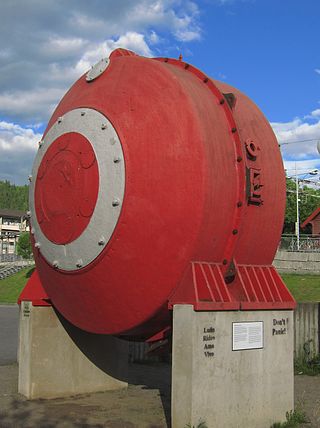热门问题
时间线
聊天
视角
伯克兰-艾德法
来自维基百科,自由的百科全书
Remove ads
伯克兰-艾德法(挪威語:Birkeland-Eyde-prosessen,英語:Birkeland–Eyde process)曾是化学工业中一种硝酸的制备方法,主要用于氮肥生产。它是一种由多个步骤组成的固氮过程:高压电弧使大气中的氮气(N2)与氧气(O2)在3000 °C高温中结合产生氮氧化物(NOx);二氧化氮(NO2)在水中溶解得到硝酸(HNO3);硝酸最终作为氮肥的生产原料,是硝酸盐的来源。[1]

本方法由挪威科学家克里斯蒂安·伯克兰研发[2],并与工业家山姆·艾德于1903年合作投产[2][3],建立在1780年代亨利·卡文迪什发现的化学现象的基础之上。[4][5]在哈伯法与奥斯特瓦尔德法发明后,本方法因能效低、耗电大,在1910-1920年代间逐渐淘汰。[6]
Remove ads
反应

反应装置核心是一个火花隙,因此有时也称电弧炉。它的两个电极由铜管制成,具有同轴式结构,采用水冷散热。两电极间施加电压5 kV、频率50 Hz的高压交流电,使火花隙反复快速放电[7],产生电弧。在电极周围,还使用与电极方向垂直的电磁铁施加一个静磁场,它产生的洛伦兹力会将电弧拉伸为碟形薄片。
碟片形电弧是温度大于3000 °C的等离子体。当空气吹过电弧时,在高温下,氮气氧化产生一氧化氮。在自然界中,大气中的闪电也能产生相同的化学反应,是可溶性硝酸盐的一个来源。[8]此外,原则上也可以使用火焰、电热铂导线、普通电弧作为热源——但效果不佳,不适合工业上大规模生产。伯克兰-艾德的碟片形电弧不但能与空气充分接触,还大幅提升了反应器的功率上限。用这种方法产生的碟片形电弧直径可达2米,发出太阳般的耀眼光芒。[6][7]

此反应速率在低温时非常缓慢,因此必须在高温下进行,降低温度会使产量下降。[9][10]20世纪初实验表明,温度大于2000 °C时,反应速率“极快”,但在1000 °C时却会“缓慢到难以测量”。[1]通过精心控制电弧的能量与气流的流速,在3000 °C时可产生4%-5%的一氧化氮。本反应能耗极高,生产一吨硝酸需要消耗15兆瓦时(15,000千瓦时)的电能,1kWh电能仅能生产60g硝酸。伯克兰的化工厂供电需要依靠附近的水力发电厂。[9][10]
高温一氧化氮随后冷却,与大气中的氧产生二氧化氮。此反应所需时间取决于空气中NO的浓度,浓度为1%时需要180秒,浓度为6%时需要40秒,产率为90%.[11]
接着,用水溶解二氧化氮产生硝酸。最后用分馏法进行提纯。[12]
吸收过程的设计对整个系统的效率至关重要。二氧化氮要通过一系列四层楼高的填料塔或板式塔,产生40-50%的硝酸(高于此浓度时,吸收速率骤降)。第一座吸收塔让气泡状的二氧化氮穿过水与不发生反应的石英碎片。当达到最终浓度后,硝酸会转移到一个花岗岩制成的容器中,塔中液体被第二座吸收塔中更稀的酸液替代。这个移动过程如此反复,气体与液体向相反的方向转移,最后一座吸收塔需要不断补充淡水。此时约20%的氮氧化物仍未反应,因此最末尾的吸收装置中含有碱性的石灰溶液,将剩余的氮氧化物转化为硝酸钙(又称挪威硝石),但仍有约2%的氮氧化物释放到空气中。[13]
硝酸是生产氮肥所需的硝酸盐离子NO3−的来源,化学式为:
Remove ads
历史
1781年,英国化学家亨利·卡文迪什在过量空气中燃烧氢,发现产生的水中含有硝酸。1785年,卡文迪什用电火花隙进一步研究发现,如果能量与氧气供应充足,空气中的氮气可全部氧化为硝酸,但仍有约1/120的少量气体不反应。1894年,瑞利勋爵重复了卡文迪什的实验,最终与威廉·拉姆齐爵士合作发现了稀有气体氩,同时也研究了能量输入与硝酸产出的关系。[1]
为提高产量与效率,后人从大量实验中得到了一系列结论:本化学反应的本质是氮气的氧化,是需要在高温下进行的未催化吸热反应;温度应大于2000度,而且一氧化氮必须能快速冷却;原则上可以使用任何一种热源,包括火焰、铂电热丝、电弧。之所以使用电弧,是因为火焰的高温区大小有限,使空气难以充分穿过,也不能迅速开关使气体有效冷却,而铂电热丝无法在金属熔点之上工作;研究还发现使用高频交流电、高阻抗、低电流时效果最佳。低电流意味着难以提升反应器功率与产能。[1]
1902年,美国人查尔斯·S·布拉德利(Charles S. Bradley)与迪米特·R·洛夫乔伊(Dimmitt R. Lovejoy)发明了一种具有多组小电极的圆形旋转火花隙反应器,他们申请了专利,成立大气产品公司(Atmospheric Products Co.),在纽约州尼亚加拉瀑布附近建立了一家小型化工厂。两人希望用廉价的水电资源支持生产,然而公司在商业上并不成功,仅两年后就停止运作[1][14],主要原因是产能低。在挪威,刚创刊不久的《电化学工业》发表了两人的研究成果。伯克兰看到这篇文章后,认为自己的单一碟形大电弧方案要优于多个小电弧。[7]
碟形电弧装置最初由德国物理学家尤利乌斯·普吕克在1861年发明。在该实验中,普吕克在火花隙周围放置U型电磁铁,使电磁铁与电极两端方向互相垂直,得到了碟片形电弧。随后瓦尔特·能斯脱等人也重复了类似的实验。[15][16]伯克兰将其工业化,从而克服了电流限制,解决了反应器的功率问题,使大规模生产实用化。[1]使用电弧的灵感,来自他之前在实验中发生短路的线圈炮发明。[17]

挪威的两个城镇留坎、诺托登曾建有使用此工艺的化工厂,并依靠附近的水力发电厂供电。1908年,诺托登工厂的固氮产量达7000吨;留坎的化工厂则是后来建成,年产量28000吨。[14]相比后来的新方法,伯克兰-艾德法能效低、耗电大。在哈伯法与奥斯特瓦尔德法发明后,本方法在1910-1920年代间被挪威工业逐渐淘汰。今日,这两个城镇的工厂成为留坎-诺托登工业遗址,被联合国教科文组织收录于《世界遗产名录》。[18]
在现代化工中,哈伯法使氢气(H2)与大气中的氮气(N2)发生反应,转化为氨(NH3)。其中的氢气通常来自甲烷(CH4),使用蒸汽重整制备。奥斯特瓦尔德法随后将氨转化为硝酸(HNO3)。[6]
Remove ads
参见
- 留坎-诺托登工业遗址
- 固氮作用
- 弗兰克-卡罗法
- 哈伯法
参考资料
Wikiwand - on
Seamless Wikipedia browsing. On steroids.
Remove ads

![{\displaystyle {\mathrm {N} {\vphantom {A}}_{\smash[{t}]{2}}{}+{}\mathrm {O} {\vphantom {A}}_{\smash[{t}]{2}}{}\mathrel {\longrightarrow } {}2\,\mathrm {NO} }}](http://wikimedia.org/api/rest_v1/media/math/render/svg/5fb3920acfbf0ead426e82023150440c2451ca4a)
![{\displaystyle {2\,\mathrm {NO} {}+{}\mathrm {O} {\vphantom {A}}_{\smash[{t}]{2}}{}\mathrel {\longrightarrow } {}2\,\mathrm {NO} {\vphantom {A}}_{\smash[{t}]{2}}}}](http://wikimedia.org/api/rest_v1/media/math/render/svg/a5db59328d7d59c903ef6f41c2d8848133604b07)
![{\displaystyle {3\,\mathrm {NO} {\vphantom {A}}_{\smash[{t}]{2}}{}+{}\mathrm {H} {\vphantom {A}}_{\smash[{t}]{2}}\mathrm {O} {}\mathrel {\longrightarrow } {}2\,\mathrm {HNO} {\vphantom {A}}_{\smash[{t}]{3}}{}+{}\mathrm {NO} }}](http://wikimedia.org/api/rest_v1/media/math/render/svg/7691eccd0f9b3c092732324dab19d30a095e7a9f)
![{\textstyle {\mathrm {HNO} {\vphantom {A}}_{\smash[{t}]{3}}{}+{}\mathrm {H} {\vphantom {A}}_{\smash[{t}]{2}}\mathrm {O} {}\mathrel {\longrightarrow } {}\mathrm {H} {\vphantom {A}}_{\smash[{t}]{3}}\mathrm {O} {\vphantom {A}}^{+}{}+{}\mathrm {NO} {\vphantom {A}}_{\smash[{t}]{3}}{\vphantom {A}}^{-}}}](http://wikimedia.org/api/rest_v1/media/math/render/svg/c3cd5d4b919b7c9a02159cce6edaa355d8814dc1)